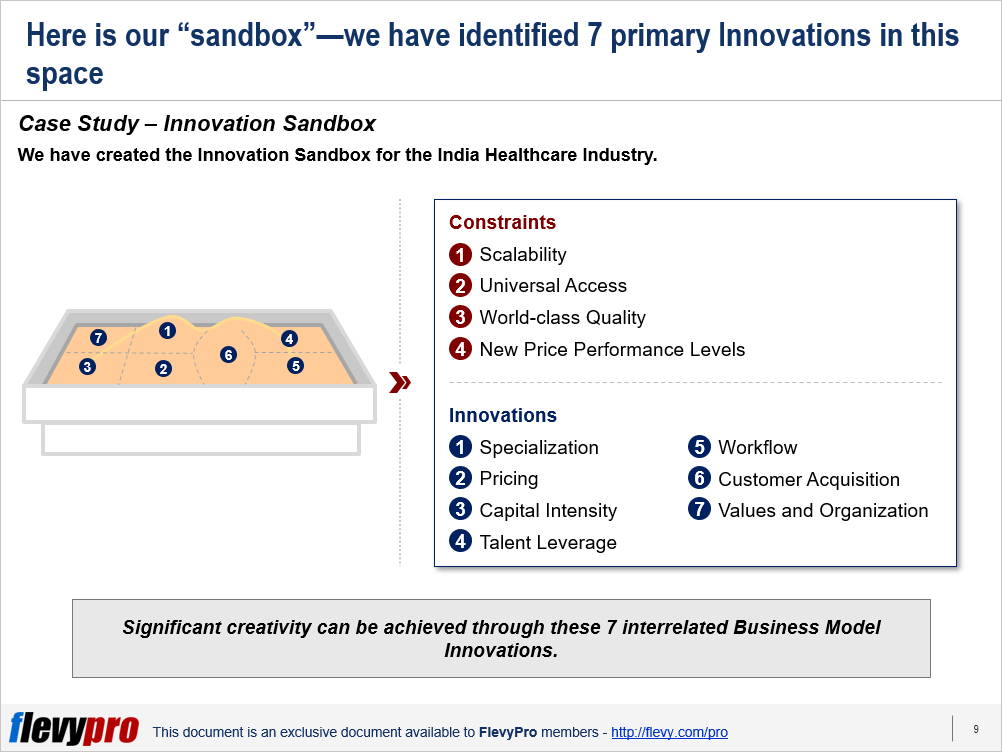Editor's Note: Take a look at our featured best practice, Design Thinking (225-slide PowerPoint presentation). [NOTE: Our Design Thinking presentation has been trusted by an array of prestigious organizations, including industry leaders such as Apple, MIT, NASA, Ford, Boeing, Fujitsu, Syngenta, Palo Alto Networks, and Mercer, to name just a few.]
Design Thinking is a process for creative problem solving. [read more]
Also, if you are interested in becoming an expert on Innovation Management, take a look at Flevy's Innovation Management Frameworks offering here. This is a curated collection of best practice frameworks based on the thought leadership of leading consulting firms, academics, and recognized subject matter experts. By learning and applying these concepts, you can you stay ahead of the curve. Full details here.
* * * *
 The “Innovation Sandbox” is a powerful creative thinking tool to drive Innovation, pioneered by C.K. Prahalad. In fact, using this framework, industries and individual organizations can achieve breakthrough Innovation. It promotes exploration and experimentation–while under extreme conditions.
The “Innovation Sandbox” is a powerful creative thinking tool to drive Innovation, pioneered by C.K. Prahalad. In fact, using this framework, industries and individual organizations can achieve breakthrough Innovation. It promotes exploration and experimentation–while under extreme conditions.
 For this framework to be implemented effectively, there are 4 core conditions that must be met:
For this framework to be implemented effectively, there are 4 core conditions that must be met:
- The Innovation must result in an offering of world-class quality.
- The innovation must achieve a significant price reduction. And, by “significant,” we mean the reduction in price should exceed 90% off the cost of a comparable offering in a “Western” country.
- The Innovation must be scalable.
- The Innovation must be affordable at the bottom of the economic pyramid. Serving bottom-of-the-pyramid customer base forces Innovation due to the extreme limitations intrinsic to serving this market.
This approach is called the Innovation Sandbox, because exploration and experimentation must be creative and free-flowing, like sand—whereas, being “boxed” in by rigid constraints. Take a look at the slide below to better visualize the “sandbox” metaphor.

Our constraints are captured by the frame of the sandbox. These core constraints are industry or market requirements that are extremely fixed. There can be more or less than 4 constraints. However, 4 is typically and there shouldn’t be many more or less.
The Innovations are illustrated inside the sandbox. With the constraints clearly defined, this then forces unconventional, creative thinking to drive Innovations. Ironically, to think of the box, we need to play in the sandbox. There can be any number of Innovations that exist in the sandbox.
There is no generic, one-size-fits-all sandbox design—as each industry, market, and business is different.
Here is an example of an Innovation Sandbox built for the India Healthcare Industry. On this slide, we have laid out the 4 constraints, plus 7 interrelated Business Model Innovations.

The India Healthcare Industry is an ideal environment to apply the Innovation Sandbox, as the constraints are obvious and extreme. More specifically, India, the second largest country in the world with a population of 1.38B people, is notorious for poor public health with numerous ailments at epidemic proportions and a scarcity of healthcare professionals. Among India’s healthcare issues include:
- High spread of HIV/AIDS
- High rates of infant mortality
- Over 6 million blind people
- Over 50 million malnourished children
- Over 100 million patients with type 2 diabetes
- Over 80% of the population cannot afford the costs of healthcare
- Health insurance unavailable to most people
- Ratio of physicians to total population less than 1 per 100,000 people
Furthermore, about 70% of the population live in rural and semi-urban areas that can be difficult to reach.
One example of a company that abides these constrains and drove such Innovations within the India Healthcare Industry is Jaipur Foot. Jaipur Foot produces a prosthetic foot made form rubber, intended for below-the-knee amputees, such as people injured by accidents and land mines. A foot costs about $30. Compare this to the $8,000 to $10,000 price of a similar Western prosthesis. This over a 99% reduction in price! In a year, the company performs about 16,000 procedures.
Another great example is Aravind Eye Care. Aravind is the world largest provider of cataract surgery. In a year, the company performs 240,000 surgeries and treats 1.6MM outpatients. Aravind treats over 60% of its patients free of charge—and the company still operates profitably!
These results seem almost too good to be true. But, following the Spartan Sandbox Innovation approach, it is possible. In fact, organizations in any industry, in any country, can adopt the Sandbox Innovation approach to breakthrough Innovation.
To elevate your chances of success requires 5 core guiding principles that management must follow:
- Radically rethink the entire business model.
- Immerse themselves in the lives of the target consumers.
- Accept constraints.
- Do not innovation in solation
- Be fully committed to a strategic intent.
In particular, I want to highlight this 3rd principle–accept the constraints! Contrary to some beliefs, breakthrough creativity requires an explicit acknowledgment of the constraints and limits. The zone of comfort drives away the zone of opportunity. With extreme constraints, we are forced out of the zone of comfort.
Also, remember, our organization cannot do all things. We must do a few things very well.
Are you interested in learning more about how to apply the Sandbox Innovation, as well as a deeper dive into the India Healthcare case study? We have a framework presentation that dives deeper in the FlevyPro Library, found here: Innovation Sandbox. It is a fully editable PowerPoint presentation and also also includes slide templates for you to use in your own business presentations.

30-slide PowerPoint presentation
Innovative business models can reshape industries and drive tremendous growth. However, many organization find business model innovation difficult. The framework outlined in this presentation is based on the HBR article "Reinventing Your Business Model," authored by Clayton Christensen, Mark
[read more]
Want to Achieve Excellence in Innovation Management?
Gain the knowledge and develop the expertise to become an expert in Innovation Management. Our frameworks are based on the thought leadership of leading consulting firms, academics, and recognized subject matter experts. Click here for full details.
To be competitive and sustain growth, we need to constantly develop new products, services, processes, technologies, and business models. In other words, we need to constantly innovate.
Ironically, the more we grow, the harder it becomes to innovate. Large organizations tend to be far better executors than they are innovators. To effectively manage the Innovation process, we need to master both the art and science of Innovation. Only then can we leverage Innovation as a Competitive Advantage, instead of viewing Innovation as a potential disruptive threat.
Learn about our Innovation Management Best Practice Frameworks here.
Readers of This Article Are Interested in These Resources

20-slide PowerPoint presentation
This toolkit contains a series of templates that are designed to capture the key elements of a innovative idea.
It is intended to a be a live document that is updated as you go through the discovery journey from idea to a revenue generating concept.
Each framework has key concepts that need
[read more]

22-slide PowerPoint presentation
Managing Innovation is an important process only few organizations master very well. It is because the Innovation process is not fully understood or implemented and the Innovation Culture is still immature.
Highly successful companies do not possess a silver Innovation bullet. They do not
[read more]

33-slide PowerPoint presentation
Partnerships among companies and universities are important drivers of the Innovation economy. Fruitful partnering with universities comprises of having the appropriate people, processes, and organizational backing to guarantee success and to detect and manage sources of conflict.
This
[read more]

22-slide PowerPoint presentation
Market pressures, technological disruption, and process related challenges adversely affect organizational performance, and force the organizations to rethink the way they do business. They end up implementing continuous process improvement or other innovation methodologies.
Continuous Process
[read more]
 The
The  For this framework to be implemented effectively, there are 4 core conditions that must be met:
For this framework to be implemented effectively, there are 4 core conditions that must be met:





